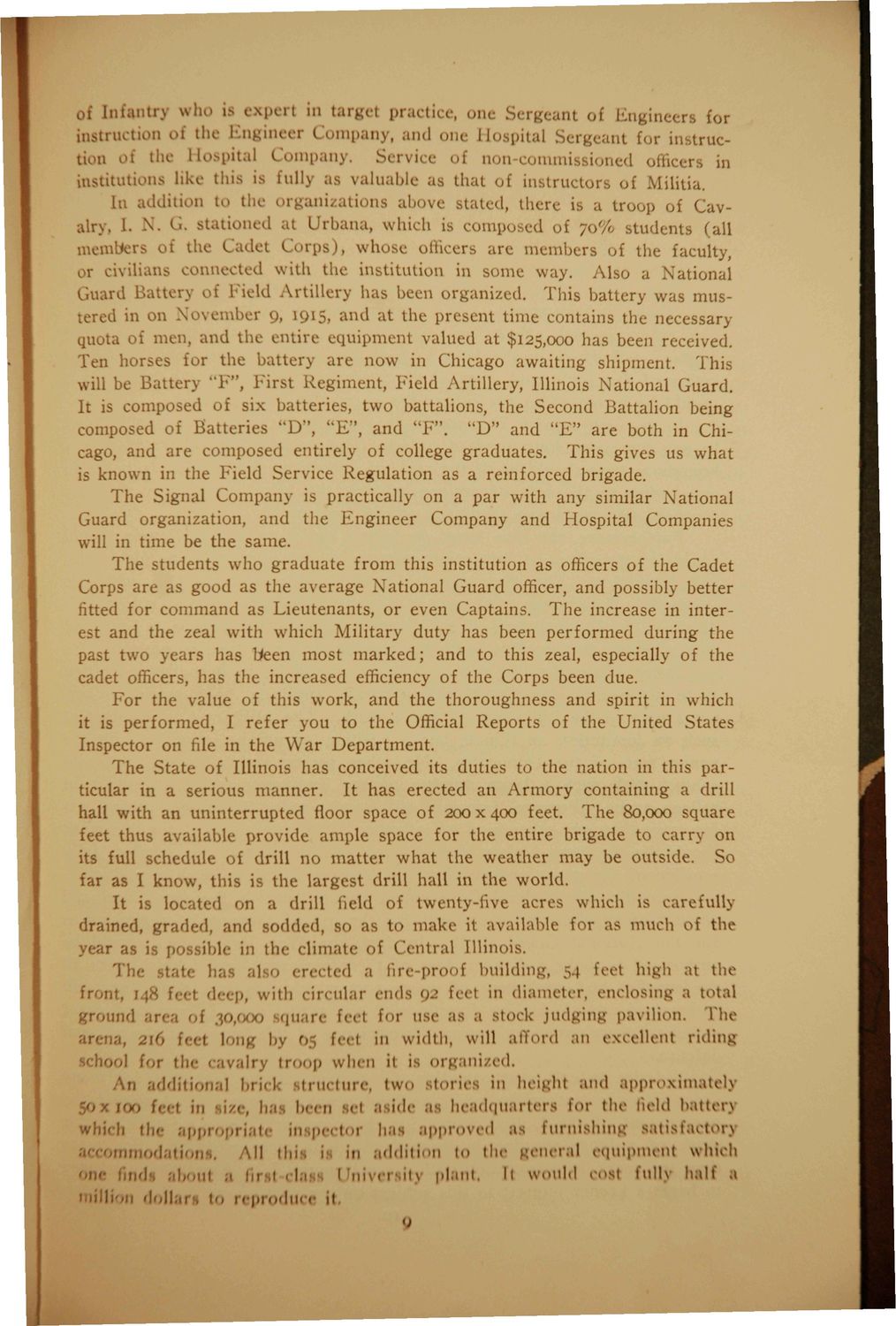| |
| |
Caption: Booklet - Military Training in our Land Grant Colleges (1916)
This is a reduced-resolution page image for fast online browsing.

EXTRACTED TEXT FROM PAGE:
ot IntautiN who is expert in target practice, one Sergeant of Engineer* for instruction < the Engineer ( ompany, and one Hospital Serg tnt for instruction of the Hospital ( mpany. Service of non-commi ioned offi :rs in institution like this is fully as valuable as that of instructors of Militia. In addition to the organizations above stated, there is a troop of Cavalry. 1. X. G, station it Urbana, which is composed of 70% students fall raemfcters of the Cadet ( >rps), whose officers are members of the faculty, r civilians connected with the institution in some way. Also a National Guard Batter} of I ield Artillery has been organized. This battery was mustered in on November 9, 1915, and at the present time contains the necessary quota of men, and the entire equipment valued at $125,000 has been received. Ten horses for the battery are now in Chicago awaiting shipment. This will be Batter) ' T " , First Regiment, Field Artillery, Illinois National Guard. It is composed of six batteries, two battalions, the Second Battalion being composed of Batteries "D", "E", and " F \ " D " and " E " are both in Chicago, and are composed entirely of college graduates. This gives us what is known in the Field Service Regulation as a reinforced brigade. The Signal Company is practically on a par with any similar National Guard organization, and the Engineer Company and Hospital Companies will in time be the same. The students who graduate from this institution as officers of the Cadet Corps are as good as the average National Guard officer, and possibly better fitted for command as Lieutenants, or even Captains. The increase in interest and the zeal with which Military duty has been performed during the past two years has been most marked; and to this zeal, especially of the cadet officers, has the increased efficiency of the Corps been due. For the value of this work, and the thoroughness and spirit in which it is performed, I refer you to the Official Reports of the United States Inspector on file in the W a r Department. The State of Illinois lias conceived its duties to the nation in this particular in a serious manner. It has erected an Armory containing a drill hall with an uninterrupted iloor space of 200x400 feet. The 80,000 square feet thus available provide ample space for the entire brigade to carry on its full schedule of drill no matter what the weather may be outside. So far as J know, this is the largest drill hall in the world. It is located on a drill field of twenty-live acres which is carefully drained, graded, and sodded, so as to make it available for as much oi the y r as is po able in the climate of Central Illinois. The state h ' o erected a lire-proof building, 54 feet high at the front, \.\H f deep, with circular ends 92 feel in diameter, enclosing a total round area of »,ooo quare feel for use as a stock judging pavilion. tructur The arena, 216 ) t long by 05 feet in width, will afford an excellent riding chool for the cavalry tn>np when it is organized. An additional bricl 50 [00 f mod t in ioni. two stories in height and approximately d as furnishing satisfactorj which e, has \i ti I aside as headquarters tor the field batter] wi h the appropriate inspi I 1 has appi ndi aboul a first-*-la l nh m i l l i o n dollar . to r e p o iu« 1 il ! All tin. is m addition to the general equipment ity plant 9 It would cost full) half a
| |